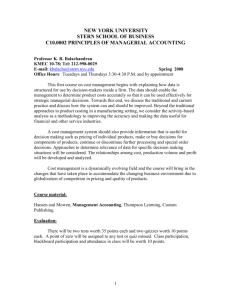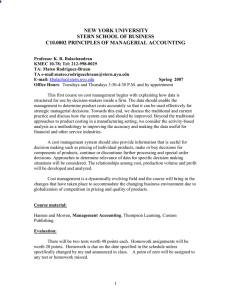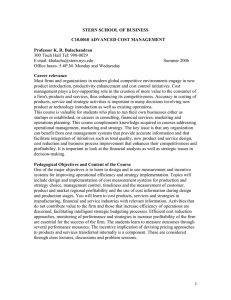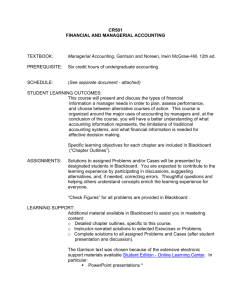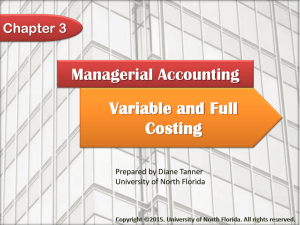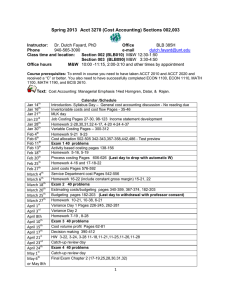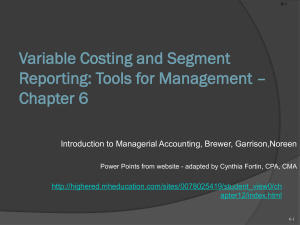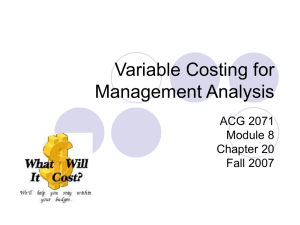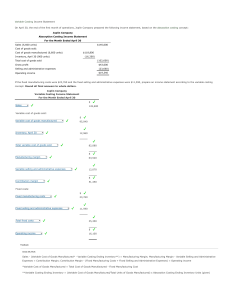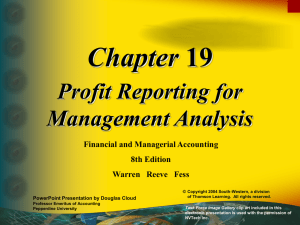NEW YORK UNIVERSITY STERN SCHOOL OF BUSINESS C10.0002 PRINCIPLES OF COST MANAGEMENT
advertisement
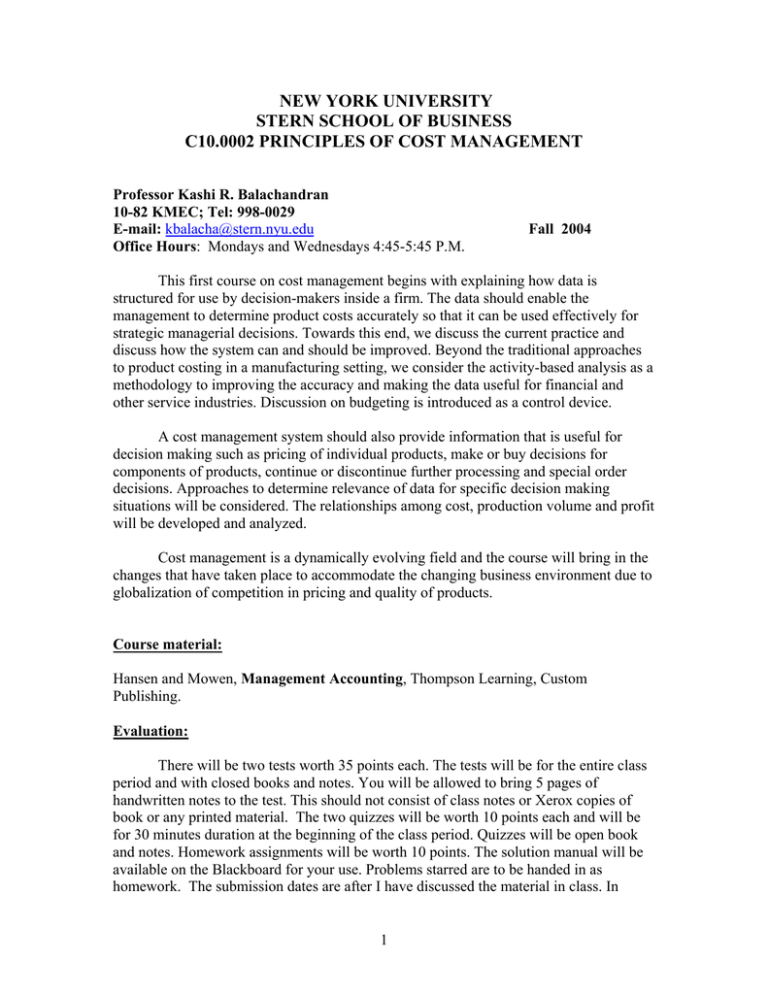
NEW YORK UNIVERSITY STERN SCHOOL OF BUSINESS C10.0002 PRINCIPLES OF COST MANAGEMENT Professor Kashi R. Balachandran 10-82 KMEC; Tel: 998-0029 E-mail: kbalacha@stern.nyu.edu Office Hours: Mondays and Wednesdays 4:45-5:45 P.M. Fall 2004 This first course on cost management begins with explaining how data is structured for use by decision-makers inside a firm. The data should enable the management to determine product costs accurately so that it can be used effectively for strategic managerial decisions. Towards this end, we discuss the current practice and discuss how the system can and should be improved. Beyond the traditional approaches to product costing in a manufacturing setting, we consider the activity-based analysis as a methodology to improving the accuracy and making the data useful for financial and other service industries. Discussion on budgeting is introduced as a control device. A cost management system should also provide information that is useful for decision making such as pricing of individual products, make or buy decisions for components of products, continue or discontinue further processing and special order decisions. Approaches to determine relevance of data for specific decision making situations will be considered. The relationships among cost, production volume and profit will be developed and analyzed. Cost management is a dynamically evolving field and the course will bring in the changes that have taken place to accommodate the changing business environment due to globalization of competition in pricing and quality of products. Course material: Hansen and Mowen, Management Accounting, Thompson Learning, Custom Publishing. Evaluation: There will be two tests worth 35 points each. The tests will be for the entire class period and with closed books and notes. You will be allowed to bring 5 pages of handwritten notes to the test. This should not consist of class notes or Xerox copies of book or any printed material. The two quizzes will be worth 10 points each and will be for 30 minutes duration at the beginning of the class period. Quizzes will be open book and notes. Homework assignments will be worth 10 points. The solution manual will be available on the Blackboard for your use. Problems starred are to be handed in as homework. The submission dates are after I have discussed the material in class. In 1 doing the homework, you should first work out the problems and then verify the answers in the manual. The assignments will not be graded in detail but you get a check for submitting complete answers and 0 otherwise. A point of zero will be assigned to any test, quiz or homework missed. You are encouraged to participate on the blackboard by writing class summaries after my class lectures. You can also use this media to raise questions about points that were not clear in the lecture and/or the homework problems and answering other students’ questions. Participation on the blackboard can help increase your final grade if you happen to fall on the border between two grades. Course Schedule Session 1: September 8 • • Product definition for manufacturing, service and retail industries Need for accurate determination of product costs • Target analysis – cost – quality considerations in the modern world • Tracing costs to activities – direct traceability and indirect traceability Assignment: HM – chapter 2: Problems: 2-2, 3, 15 Session 2: September 13 • Cost concepts: directly traceable, indirectly traceable with reference to cost objects • Cost drivers for activities • Definitions of product costs – inventoriable product costs, whole product cost, lifetime product cost, customer’s view of product cost Assignment: HM – chapters 2: Problems: 2-6, 7, 9*, 10 Session 3: September 15 • Cost of goods manufactured and income statement formats. • Continuation of inventoriable product costs • Variable and fixed costs – with respect to relevant ranges • Unused capacities management Assignment: HM- chapter 2, 3 (up to page 79) Problems: 2-17*, 18, 19; 32, 3, 7. Session 4: September 20 • Activity based costing systems 2 • • • • Accumulating activity costs Determining cost driver rates Simplifying using cost pools Determining product costs Assignment: HM chapter 4: Problems: 4- 3, 5*, 7 Session 5: September 22 QUIZ 1 • Approximations to ABC systems – combining batch level, product sustaining level and facilities level into one overhead pool • Consideration of inventoriable product costs and traditional job order costing Assignment: HM-chapter 4: Problems: 4-11, 16, 18* Session 6: September 27 • • • Factory product costs and period costs Overhead application Unit product costs Assignment: HM-chapter 5; Problems: 5- 3, 11*, 18 Session 7: September 29 TEST 1 Session 8: October 4 • Absorption format income statement for financial reporting • Variable (Direct) costing format income statement for decision making Assignment HM-chapter 15: Problems: 15-2, 3, 8*, 10 Session 9: October 6 • • • • • Analyzing survivability and profit maximization Assumptions behind elementary breakeven analysis Breakeven formula derivation and significance Profit- volume graphs and its usefulness Contribution margin and contribution margin ratio- interpretations Assignment: HM- chapter 16: Problems: 16-4, 5, 9*, 13. Session 10: 3 October 11 QUIZ 2 • Segmented income statement Assignment: HM-chapter 15: Problems: 15-18, 23*. Session 11: October 13 • • • Relevance of past costs, present costs and future costs for decision making Effects of taxation , time value of money and opportunity costs on the concept of relevance How to choose alternatives and decide on the minimal information needed for decision making Assignment: HM- chapter 17; Problems: 17-3, 4, 5* Session 12: October 18 • • • • Typical keep or sell and make or buy decisions- information needs Role of cost allocation in product costing and the need for better decision making Decisions using incremental analysis, contribution margin per unit and contribution margin per unit resource consumed Historical costs, sunk costs, opportunity costs Assignment: Problems: 17-10, 11, 13, 17* Session 13: October 20 FINAL EXAM 4
